Dutch elm disease
|
|
|
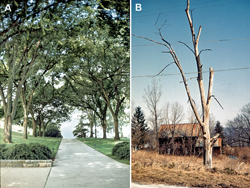 |
|
 |
C12.1. American elms and the effect of Dutch elm disease. A, American elms were popular because of their overarching growth, which provided shade over streets. The street-lining planting pattern increased the demise of the elm due to Dutch elm disease, because Ophiostoma species move through xylem connections in root grafts between neighboring trees. (Photo taken in 1975 at Longwood Gardens, PA.) B, American elm that has died of Dutch elm disease.
|
|
C12.2. Infection of an elm tree. A, egg gallery of the European elm bark beetle, Scolytus multistriatus. The female beetle lays eggs in the maternal tunnel, which runs parallel to the grain of the wood; larval tunnels, produced by feeding larvae, are perpendicular to the maternal tunnel. B, conidia of Ophiostoma species are produced on synnemata that are produced in egg galleries under the bark of dying or recently dead elm trees. Emerging adult beetles become contaminated with the sticky conidia. (Left, light micrograph; Right, scanning electron micrograph.) |
| |
|
|
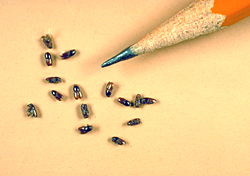 |
|
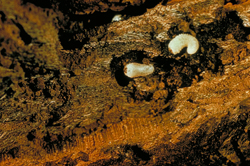 |
C12.3. Adult elm bark beetles.
|
|
C12.4. Larvae of the European elm bark beetle in the bark of an elm tree. |
|
|
|
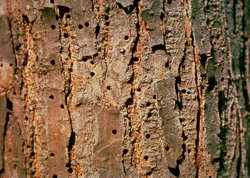 |
|
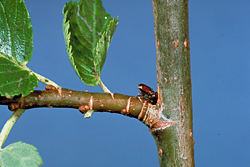 |
| C12.5. Emergence holes in elm bark made by adult elm bark beetles. . |
|
C12.6. European elm bark beetle feeding in the twig crotch of an elm tree. |
| |
|
|
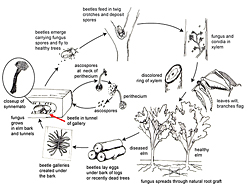 |
|
|
| Disease cycle of dutch elm disease, caused by Ophiostoma ulmi and O. novo-ulmi. |
|
|
|
|
|
Chestnut blight |
|
|
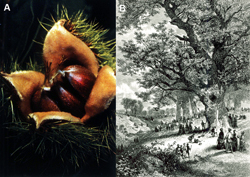 |
|
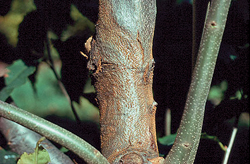 |
| C12.7. Nuts of the American chestnut, Castanea dentata. A, burr with nuts. B, chestnut trees in Fairmount Park, Philadelphia, in 1878, and people harvesting the nuts with ladders. |
|
C12.8. Chestnut blight canker. The numerous, tiny orange structures are fruiting bodies of the pathogen. .
|
|
|
|
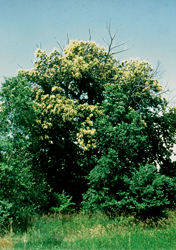 |
|
|
| C12.9. A chestnut tree in Michigan recovering from chestnut blight because of naturally occurring hypovirulent strains of the pathogen.. |
|
|
| |
|
|
Other Canker Diseases |
|
|
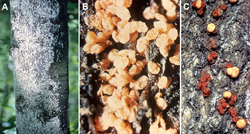 |
|
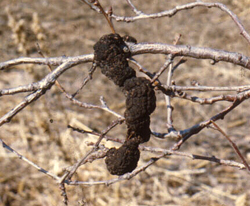 |
| C12.10. Diseased beech tree. A, an American beech, Fagus sylvatica, infested with beech scale, Cryptococcus fagisuga. B, scales with waxy coating removed. C, fruiting bodies of the Nectria fungi emerging through the bark of an infected tree. Canker fungi are lethal to beech when they gain entry through wounds made by feeding scale insects. |
|
C12.11. Black knot canker disease of cherry and plum, caused by Apiosporina morbosa.
|
|
|
|
|
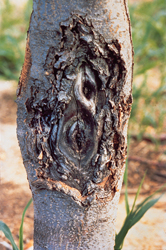 |
|
|
| C12.12. Canker with perennial rings of callus growth as the tree fights back against the canker pathogen. |
|
|
|
|
|
|
Wood decay
|
|
|
|
|
|
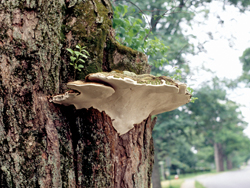 |
|
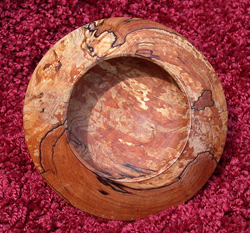 |
C12.13. Fruiting body (conk) of a wood decay basidiomycete on the trunk of an infected tree. Basidiospores are produced in the tiny pores on the lower surface. Removing the conk will not save the tree.
|
|
C12.14. This bowl was turned from a solid piece of spalted sugar maple burl wood by D. R. Bergdahl, professor emeritus of forest pathology. Note the irregular grain pattern associated with burl formation. Black to brown zone lines and light colored wood (spalting) form as different strains of wood decay fungi (mostly, "white rotters") wall themselves off from genetically incompatible strains. The decay and spalting process stops once the wood is dried. |
|
|
|
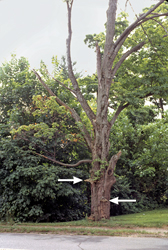 |
|
|
| C12.15. Tree declining because of infection by a wood-decay fungus. Note the fruiting bodies (arrows) on the trunk of the tree. Many wood decay fungi can degrade the lignin that makes wood heavy and strong. |
|
|
|
|
|
|
Armillaria root rot
|
|
|
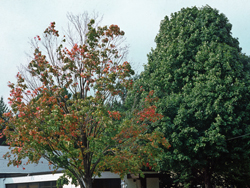 |
|
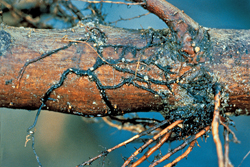 |
| C12.16. A sugar maple stressed by parking lot paving (left) has developed Armillaria root rot. |
|
C12.17. Rhizomorphs ("shoestrings") of an Armillaria species adhering to the roots of an infected tree. |
|
|
|
Parasitic Plants |
|
|
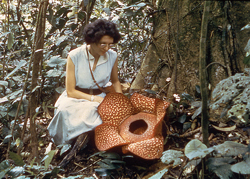 |
|
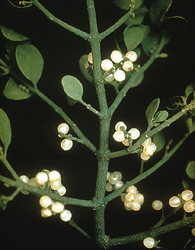 |
| C12.18. Rafflesia arnoldii, which produces the largest flower in the world, is a parasite of a tropical vine. |
|
C12.19. Leaves, stems, and berries of the mistletoe commonly hung at Christmas. |
|
|
|
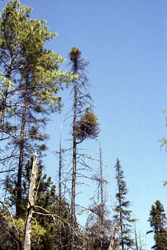 |
|
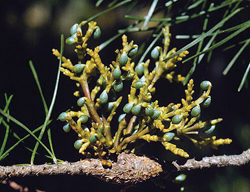 |
| C12.20. Spruce tree with distorted growth resulting from infection by dwarf mistletoe in northern Michigan. |
|
C12.21. A female (fruiting) dwarf mistletoe parasitizing a shore pine in British Columbia, Canada. |
|
|
|
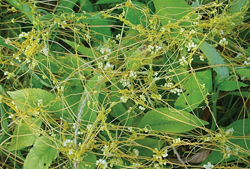 |
|
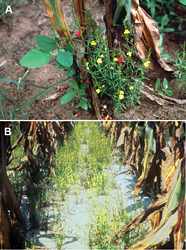 |
C12.22. Dodder (Cuscuta species) parasitizing herbaceous plants.
|
|
C12.23. Witchweed, (Striga species), a parasite of host roots. A, at the base of a corn plant. B, corn growing poorly due to witchweed infection. Witchweed plants can be seen between the corn rows. |
|
|
|
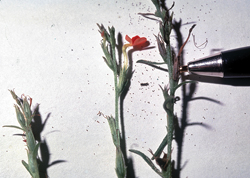 |
|
|
| C12.24. Witchweed seeds, scattered on the paper beneath the plants, are numerous and tiny. |
|
|
|
|
|
